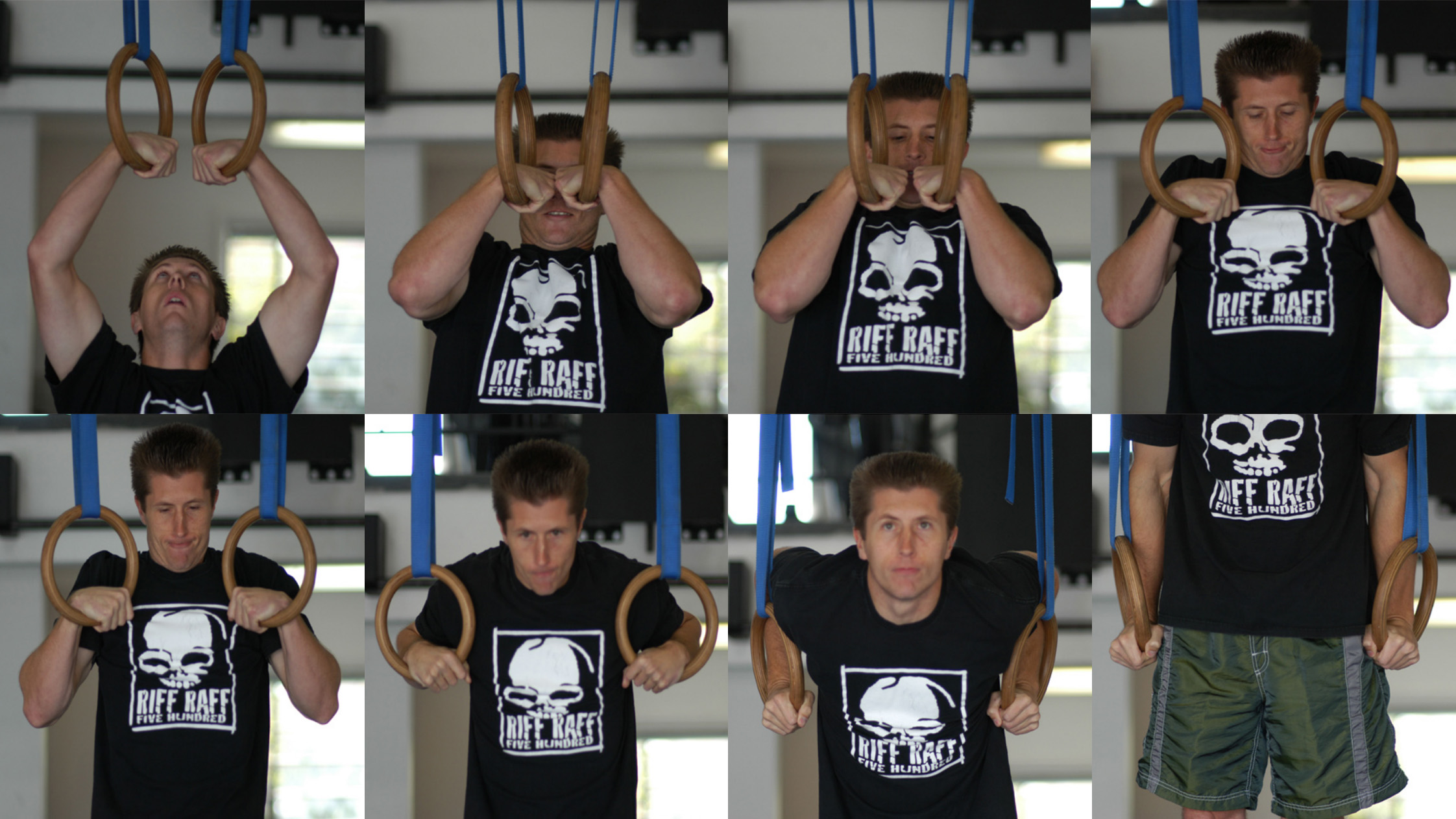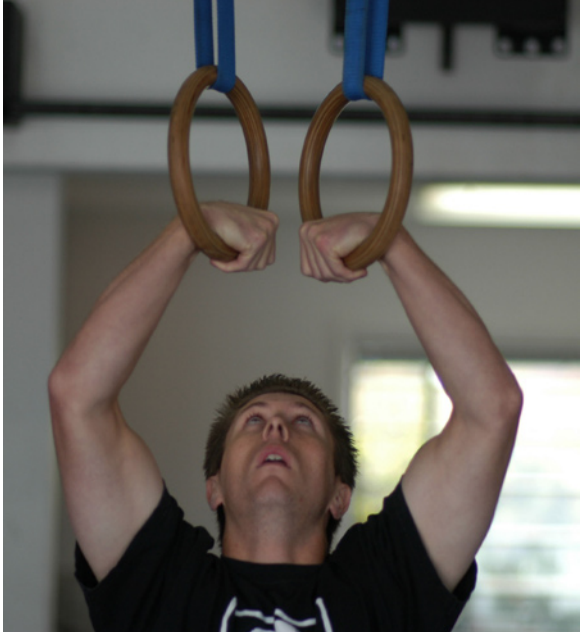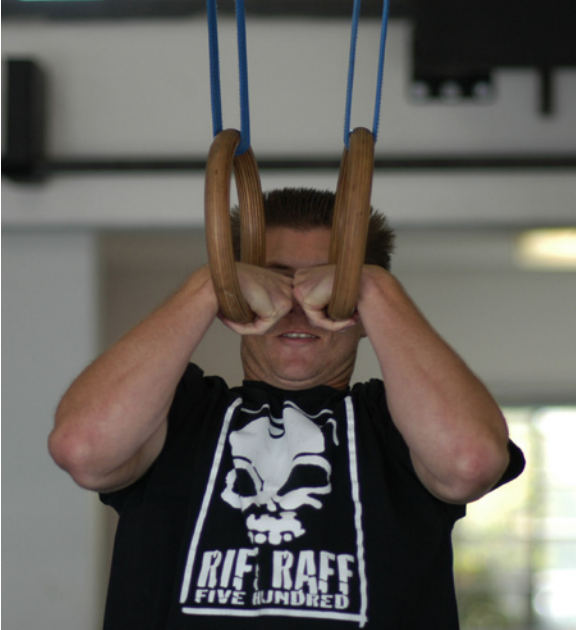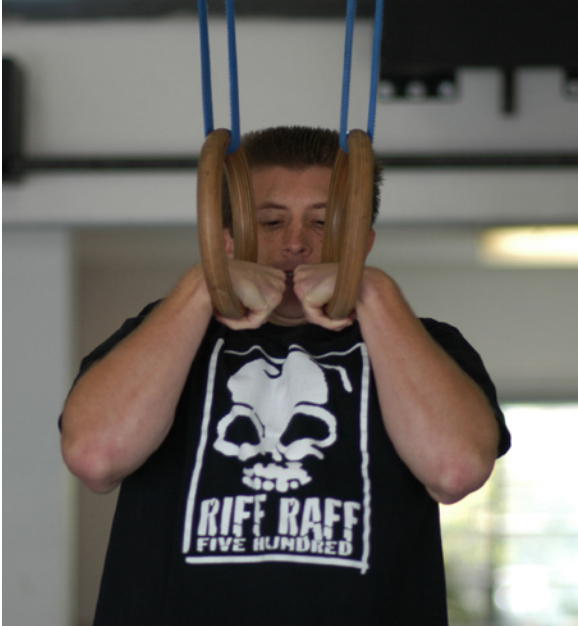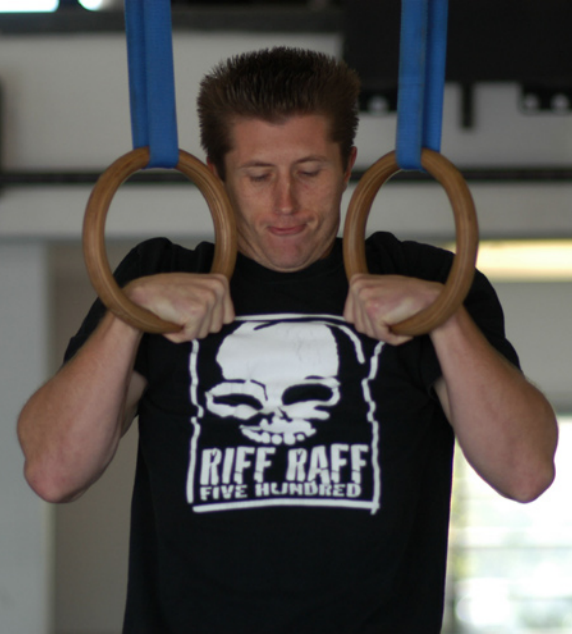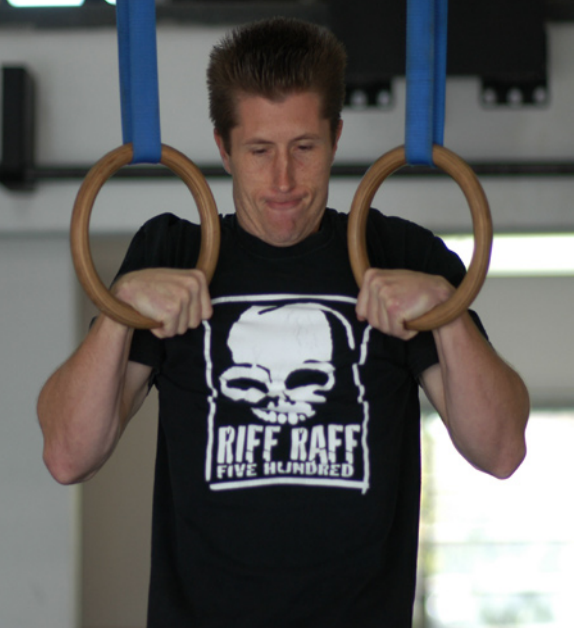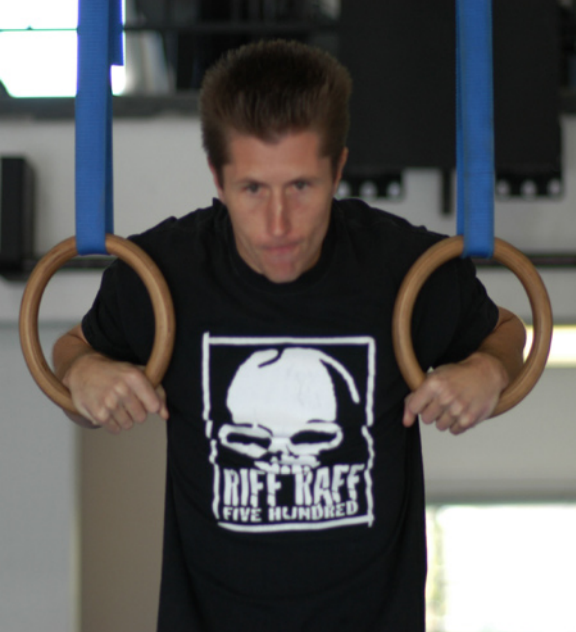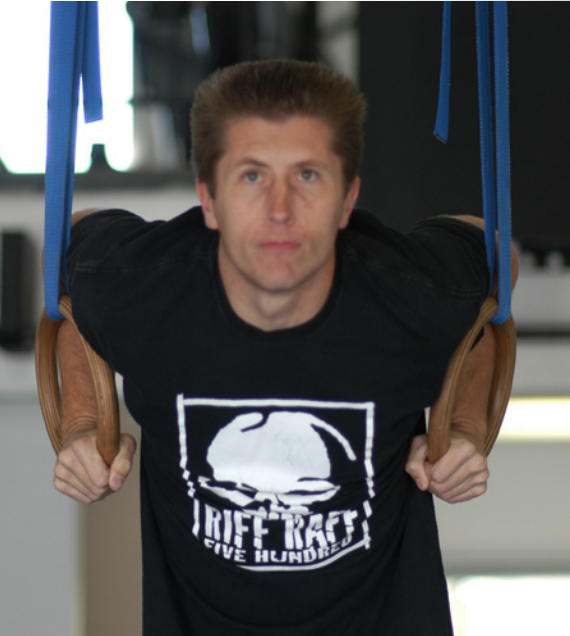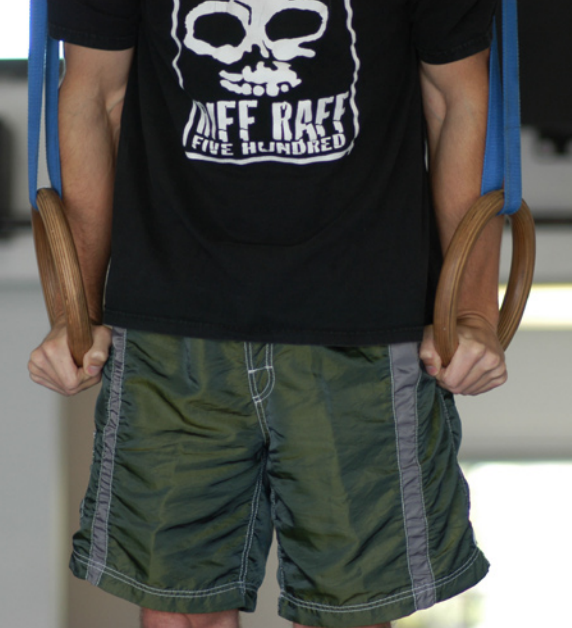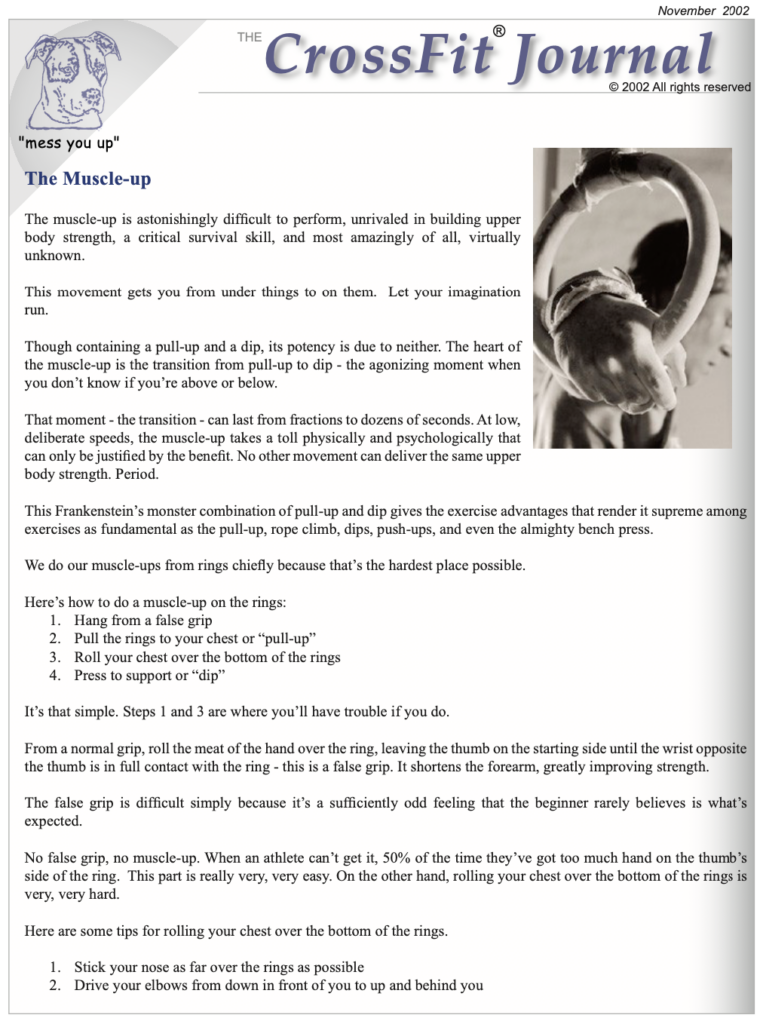The muscle-up is astonishingly difficult to perform, unrivaled in building upper body strength, a critical survival skill, and most amazingly of all, virtually unknown. This movement gets you from under things to on them. Let your imagination run. Though containing a pull-up and a dip, its potency is due to neither. The heart of the muscle-up is the transition from pull-up to dip – the agonizing moment when you don’t know if you’re above or below.
That moment – the transition – can last from fractions to dozens of seconds. At low, deliberate speeds, the muscle-up takes a toll physically and psychologically that can only be justified by the benefit. No other movement can deliver the same upper body strength. Period. This Frankenstein’s monster combination of pull-up and dip gives the exercise advantages that render it supreme among exercises as fundamental as the pull-up, rope climb, dips, push-ups, and even the almighty bench press.
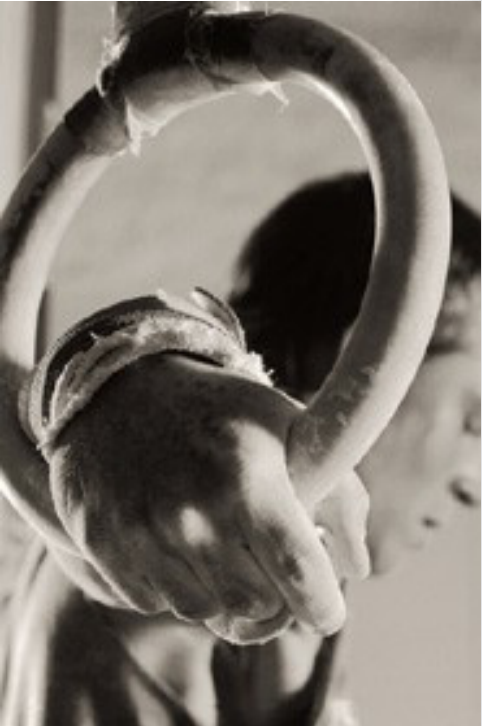
Here’s how to do a muscle-up on the rings:
- Hang from a false grip
- Pull the rings to your chest or “pull-up”
- Roll your chest over the bottom of the rings
- Press to support or “dip”
It’s that simple. Steps 1 and 3 are where you’ll have trouble if you do.
From a normal grip, roll the meat of the hand over the ring, leaving the thumb on the starting side until the wrist opposite the thumb is in full contact with the ring—this is a false grip. It shortens the forearm, greatly improving strength.
The false grip is difficult simply because it’s a sufficiently odd feeling that the beginner rarely believes it’s what’s expected.
No false grip, no muscle-up. When an athlete can’t get it, 50 percent of the time they’ve got too much hand on the thumb’s side of the ring. This part is really very, very easy. On the other hand, rolling your chest over the bottom of the rings is very, very hard.
But, once you get it, anything you can get a finger-hold on, you can surmount. You’ll be able to jump for something, catch it with only two fingers, pull in two more, choke up to the false grip and, “boom!”—you’re on top. Military, police and firefighter applications are too obvious to mention.
Less obvious are the martial applications where alternately pulling and pushing from awkward angles is routine. Our Jiu-jitsu guys recognize at once the utility of strength along these body lines, as well as the strength and advantage of the false grip.
Here are some tips for rolling your chest over the bottom of the rings:
- Stick your nose as far over the rings as possible
- Drive your elbows from down in front of you to up and behind you
- Keep the rings as close to your body as possible
- Tighten your gut
- Have the meat of the thumb trace a line from collarbone to the armpit, just above the nipple
Ultimately, none of this really helps; you just have to struggle with it until you get it.
Assuming the grip is OK—you’ll know it is if you get deep bruises on the wrist opposite the thumb—there are two other common barriers to the muscle-up.
First, not being strong enough. Here’s the litmus: if you can do 15 good pull-ups and 15 good dips, then you’re strong enough. If you can’t, work your pull-ups and dips overtime until you can do the muscle-up.
If you can do the pull-ups and dips, your grip is good (you’re getting bruised wrists) and you’re still unable to get above the rings, then you’re either letting the rings wander away from your body or you aren’t trying hard enough.
The muscle-up gets noticeably harder with every quarter inch the ring moves away from the body. Keep the rings in as close to your body as you can. Only a buddy can tell you if they’re wandering or not. Typically the struggler has no sense of where he is.
As weird as it sounds, not trying hard enough is common among even the most accomplished athletes. Don’t give up on each attempt until you’ve struggled for 10 seconds with the rings at the chest. This part is very hard.
How hard? Not very, really. Gymnastics moves are graded “A” through “E,” “A” being easiest and “E” hardest. The muscle-up is an “A” move. That’s right, easiest. So it’s easy for gymnasts and nearly impossible for most everyone else.
But, once you get it, anything you can get a finger-hold on, you can surmount. You’ll be able to jump for something, catch it with only two fingers, pull in two more, choke up to the false grip and, “boom!”—you’re on top. Military, police and firefighter applications are too obvious to mention.
Less obvious are the martial applications where alternately pulling and pushing from awkward angles is routine. Our Jiu-jitsu guys recognize at once the utility of strength along these body lines, as well as the strength and advantage of the false grip.
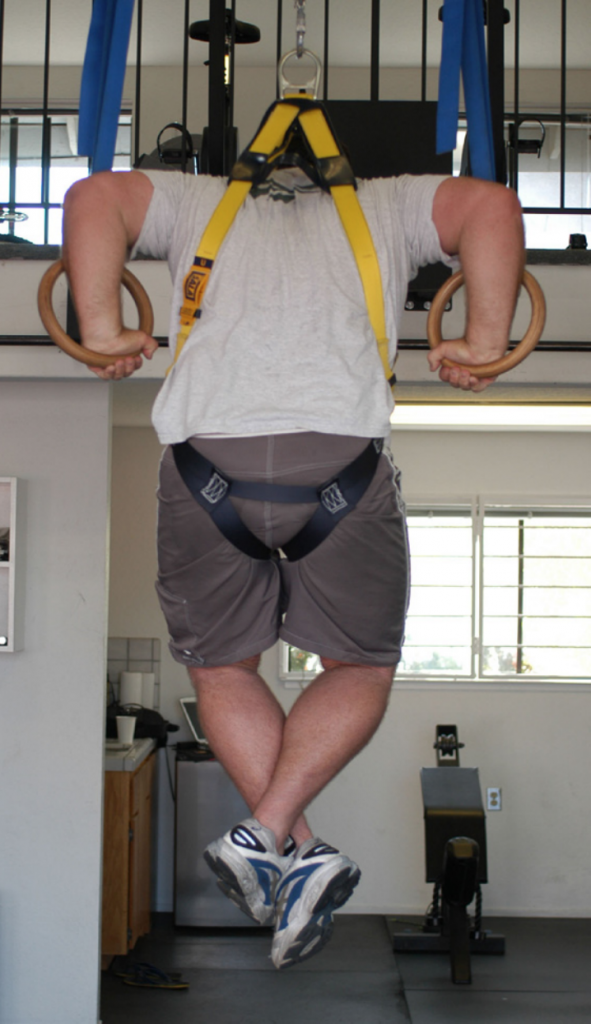
You can assist the muscle-up with an easy push under the rump during the transition. It’s important for the spotter to push gently, and straight up. The athlete’s legs will typically rise, leaving him in a near-seated position from which directing a push “up” and not “out” will be easy.
An effective workout would be for two athletes, regardless of ability to perform the muscle-up, to alternately assist and work in sets of five reps. Thirty muscle-ups, each completed to lockout, is a good workout for most people. Fifty will cover the needs of even elite barbarians.
If you still don’t have rings, you’re running out of excuses. There are options for every budget and workout facility. See “Ring Buyer’s Guide.”
Rings were a regular feature of gymnasiums until modern times. Strangely, this perfect tool for perfecting upper-body development has fallen to newer fashions and a disregard for challenging or even slightly technical elements.
Help reverse this trend and you’ll benefit immensely. So buy some rings, set them up and use them—starting with the muscle-up.

Garth Taylor is being assisted by a “Delta No-Tangle Harness, Vest Style” by Sala (651.388.8282) connected overhead to a block and tackle assembly with a 4:1 purchase by Harken. This allows for a near perfect assistance – the line of action is not altered by the assistance (compare to Loyd Lewis). In assisting the muscle-up the key is to gently and slowly aid the transition. The challenge is to keep the athlete moving through the transition but slowly. The Sala vest and block and tackle provide for a method that not only doesn’t alter the line of action but also gives fantastic tactile feedback to the spotter. You can, by this method, assist perfectly without even looking at the athlete – the sticking point can be easily felt.
This article, by BSI’s co-founder, was originally published in The CrossFit Journal. While Greg Glassman no longer owns CrossFit Inc., his writings and ideas revolutionized the world of fitness, and are reproduced here.
Coach Glassman named his training methodology ‘CrossFit,’ which became a trademarked term owned by CrossFit Inc. In order to preserve his writings in their original form, references to ‘CrossFit’ remain in this article.
Download a pdf of the original article HERE.
Greg Glassman founded CrossFit, a fitness revolution. Under Glassman’s leadership there were around 4 million CrossFitters, 300,000 CrossFit coaches and 15,000 physical locations, known as affiliates, where his prescribed methodology: constantly varied functional movements executed at high intensity, were practiced daily. CrossFit became known as the solution to the world’s greatest problem, chronic illness.
In 2002, he became the first person in exercise physiology to apply a scientific definition to the word fitness. As the son of an aerospace engineer, Glassman learned the principles of science at a young age. Through observations, experimentation, testing, and retesting, Glassman created a program that brought unprecedented results to his clients. He shared his methodology with the world through The CrossFit Journal and in-person seminars. Harvard Business School proclaimed that CrossFit was the world’s fastest growing business.
The business, which challenged conventional business models and financially upset the health and wellness industry, brought plenty of negative attention to Glassman and CrossFit. The company’s low carbohydrate nutrition prescription threatened the sugar industry and led to a series of lawsuits after a peer-reviewed journal falsified data claiming Glassman’s methodology caused injuries. A federal judge called it the biggest case of scientific misconduct and fraud she’d seen in all her years on the bench. After this experience Glassman developed a deep interest in the corruption of modern science for private interests. He launched CrossFit Health which mobilized 20,000 doctors who knew from their experiences with CrossFit that Glassman’s methodology prevented and cured chronic diseases. Glassman networked the doctors, exposed them to researchers in a variety of fields and encouraged them to work together and further support efforts to expose the problems in medicine and work together on preventative measures.
In 2020, Greg sold CrossFit and focused his attention on the broader issues in modern science. He’d learned from his experience in fitness that areas of study without definitions, without ways of measuring and replicating results are ripe for corruption and manipulation.
The Broken Science Initiative, aims to expose and equip anyone interested with the tools to protect themself from the ills of modern medicine and broken science at-large.
Support the Broken Science Initiative.
Subscribe today →
recent posts
Metabolic Flexibility to Burn Fat, Get Stronger, and Get Healthier
Expanding Horizons: Physical and Mental Rehabilitation for Juveniles in Ohio
